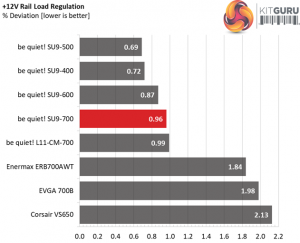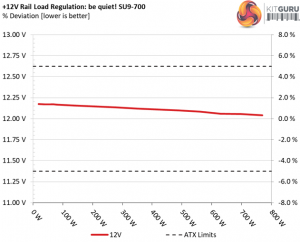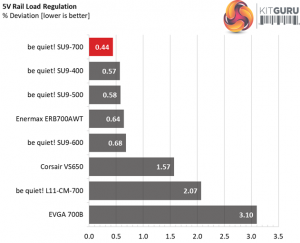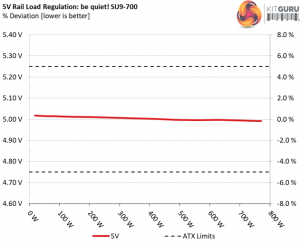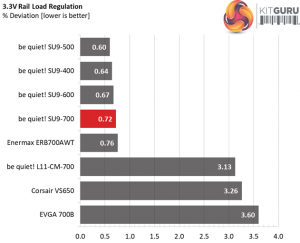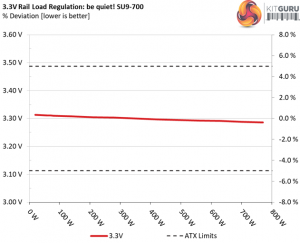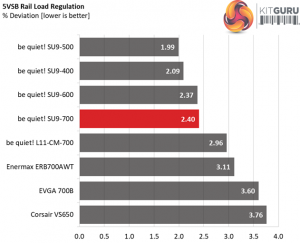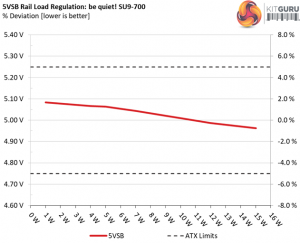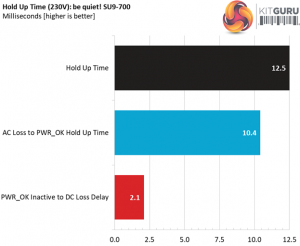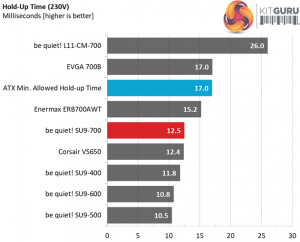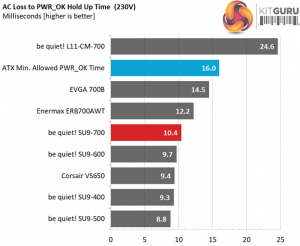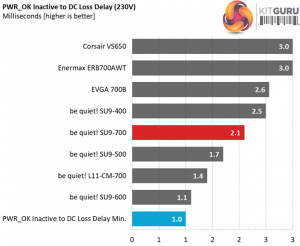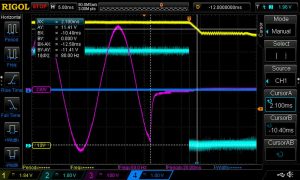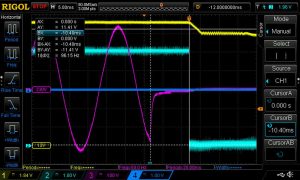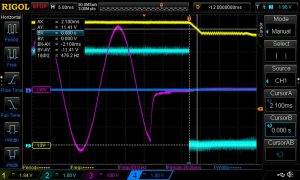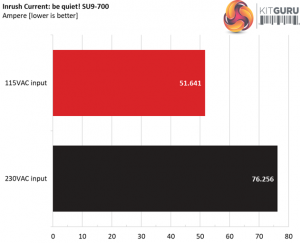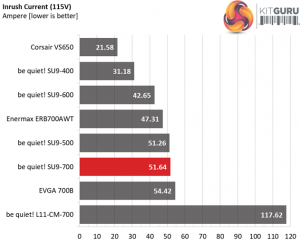To learn more about our PSU tests and methodology, please check out How We Test Power Supply Units.
Primary Rails And 5VSB Load Regulation
Load Regulation testing is detailed here.
Hold-Up Time
Our hold-up time tests are described in detail here.
The oscilloscope screenshots that we took during the hold-up time measurements:
The hold-up time is much lower than 17ms. This was expected since the bulk cap is small. At least the power ok signal is accurate.
Inrush Current
For details on our inrush current testing, please click here.
The inrush current is high, with both voltage inputs.
Load Regulation And Efficiency Measurements
The first set of tests reveals the stability of the voltage rails and the SU9-700’s efficiency. The applied load equals (approximately) 10 to 110 percent of the power supplies maximum load in increments of 10 percentage points.
We conducted two additional tests.
During the first, we stressed the two minor rails (5V and 3.3V) with a high load, while the load at +12V was only 0.1A. This test reveals whether a power supply is compatible with Intel’s C6/C7 sleep states or not. In the second test, we determined the maximum load the +12V rail could handle with minimal load on the minor rails.
| Test # | 12V | 5V | 3.3V | 5VSB | DC/AC (Watts) | Efficiency | Fan Speed (RPM) | PSU Noise (dB[A]) | Temps (In/Out) | PF/AC Volts |
| 1 | 3.950A | 1.995A | 1.992A | 0.988A | 69.671 | 82.690% | 633 | 10.0 | 36.53°C | 0.963 |
| 12.170V | 5.014V | 3.311V | 5.063V | 84.256 | 39.66°C | 115.26V | ||||
| 2 | 8.955A | 2.994A | 2.992A | 1.188A | 139.782 | 87.420% | 630 | 10.0 | 36.82°C | 0.970 |
| 12.158V | 5.012V | 3.308V | 5.053V | 159.897 | 40.68°C | 115.18V | ||||
| 3 | 14.303A | 3.492A | 3.479A | 1.388A | 209.703 | 88.568% | 628 | 9.9 | 37.23°C | 0.979 |
| 12.145V | 5.010V | 3.305V | 5.043V | 236.770 | 41.96°C | 115.18V | ||||
| 4 | 19.658A | 3.998A | 3.999A | 1.590A | 279.738 | 88.671% | 635 | 10.1 | 37.46°C | 0.984 |
| 12.133V | 5.007V | 3.303V | 5.032V | 315.478 | 42.75°C | 115.07V | ||||
| 5 | 24.697A | 4.999A | 4.999A | 1.793A | 349.866 | 88.248% | 628 | 9.9 | 37.87°C | 0.988 |
| 12.121V | 5.004V | 3.300V | 5.021V | 396.458 | 44.07°C | 114.97V | ||||
| 6 | 29.742A | 6.001A | 6.008A | 1.997A | 419.977 | 87.487% | 630 | 10.0 | 38.09°C | 0.990 |
| 12.109V | 5.002V | 3.297V | 5.010V | 480.045 | 45.86°C | 114.97V | ||||
| 7 | 34.794A | 7.005A | 7.012A | 2.202A | 490.129 | 86.354% | 656 | 10.7 | 38.70°C | 0.992 |
| 12.100V | 4.998V | 3.295V | 4.998V | 567.579 | 47.30°C | 114.84V | ||||
| 8 | 39.863A | 8.009A | 8.020A | 2.407A | 560.201 | 85.146% | 948 | 20.0 | 39.27°C | 0.993 |
| 12.086V | 4.996V | 3.292V | 4.986V | 657.928 | 48.49°C | 114.73V | ||||
| 9 | 45.371A | 8.505A | 8.505A | 2.409A | 629.666 | 84.062% | 988 | 21.1 | 39.93°C | 0.994 |
| 12.060V | 4.997V | 3.291V | 4.982V | 749.046 | 49.86°C | 114.65V | ||||
| 10 | 50.603A | 9.013A | 9.032A | 3.024A | 699.733 | 82.687% | 1530 | 34.8 | 40.53°C | 0.995 |
| 12.055V | 4.994V | 3.288V | 4.962V | 846.238 | 50.79°C | 114.60V | ||||
| 11 | 56.481A | 9.013A | 9.038A | 3.028A | 769.783 | 81.321% | 1812 | 39.2 | 40.90°C | 0.995 |
| 12.041V | 4.992V | 3.286V | 4.955V | 946.599 | 51.94°C | 114.46V | ||||
| CL1 | 0.134A | 16.002A | 16.000A | 0.000A | 134.392 | 79.577% | 644 | 10.4 | 37.76°C | 0.973 |
| 12.165V | 4.997V | 3.300V | 5.056V | 168.884 | 44.31°C | 115.15V | ||||
| CL2 | 55.997A | 1.000A | 0.999A | 1.000A | 688.785 | 83.455% | 1445 | 32.8 | 40.48°C | 0.994 |
| 12.063V | 4.996V | 3.291V | 5.009V | 825.340 | 50.52°C | 114.63V |
For a budget-oriented product, the load regulation performance is amazing! The +12V, 5V and 3.3V rails stay within 1% and the platform doesn't have a problem delivering more than its nominal capacity at over 40°C ambient. Moreover, we have to push it really hard in order to make the fan spin at high speeds and still only in the overload scenario the acoustics noise reached close to 40 dB(A).
The performance with highly unbalanced loads among the rails is very good, since DC-DC converters are used for the generation of the minor rails. Moreover, the PF readings look good as well.
The 80 PLUS Bronze requirements are easily met in all three load scenarios (20%, 50% and 100%), even at high operating temperatures.
 KitGuru KitGuru.net – Tech News | Hardware News | Hardware Reviews | IOS | Mobile | Gaming | Graphics Cards
KitGuru KitGuru.net – Tech News | Hardware News | Hardware Reviews | IOS | Mobile | Gaming | Graphics Cards


